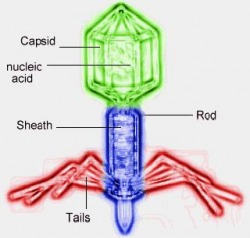All About Viruses and Bacteria
What Are Viruses

Simple Virus Structure
Have you ever wondered what makes you sick? It's not going out side in the cold or from playing in the dirt, but from macrobiotic parasites called viruses. Viruses are small infectious agents that invade a human body or animal body and causes infection. They come in many shapes and sizes, either geometrical or simple, and can do many different things. They are all 20 to 250 nanometers in size. There are over one million nanometers just in the width of one of your hairs on your head. A virus needs a host to survive. A host can be anything that is living and can provide the needs of the virus. A host can be a cell in your body, an animal’s body, or even bacteria cell. When a virus is outside of a host it remains dormant. When it enters an environment where it will thrive, it will become active and begin to seek a host cell. When it finds a host cell it takes over that cell and uses its resources to make more viruses. Most people would think viruses are living things, but they are actually not. Scientists do not classify viruses as living things because they do not meet all the characteristic of living things. They need host cells to survive, and a living thing needs to be able to sustain itself in order to survive. Viruses are more similar to robots than a living cell. A viruses head doesn't contain a brain, but contains its DNA or RNA. That DNA or RNA contains the information it needs to survive. Viruses do more than just enter your body and reproduce; it causes your body to act differently than it should. In other words, your body becomes sick. Your body then has to fight the infection by causing things like a fever or inflammation. Viruses are very deadly and huge threat to us. Unlike bacteria, they almost always cause infections. Viruses are spread by touching something that is infected by viruses and then touching your eyes, nose, mouth, or an open cut. This allows the virus to spread within your body. Although all viruses are different they share some of the same parts. A simple virus is shown in the picture to the left. It is made up of two main parts. The fists part is the head. It is made up of a capsid that contains the viruses DNA or RNA. The capsid also contains nucleic acid. The other part of the virus is the tail. The tail is made up of the sheath contained inside a rod. The tail also contains the tail fibers. That is how a simple virus is composed, but a complex virus is composed a bit differently. It still has a capsid that contains the viruses DNA or RNA, but it is now surrounded by a layer of lipids and a protein coat. The protein coat is made of Neuraminidase and Hemagglutinin. These proteins are a key part of the virus. More information can be found on them in the flu different types and strains.

